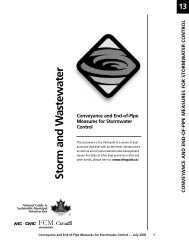Whitehorse Climate Change Adaptation Plan - Yukon College
Whitehorse Climate Change Adaptation Plan - Yukon College
Whitehorse Climate Change Adaptation Plan - Yukon College
Create successful ePaper yourself
Turn your PDF publications into a flip-book with our unique Google optimized e-Paper software.
to shifting seasonal conditions because of its directional flow (flows south to north) and its<br />
many tributaries. Seasonally, river levels rise in the fall and spring, driven by increased levels<br />
of precipitation, and ebb at the end of the summer. Cold weather can cause ice-jamming and<br />
flooding as the river does not freeze completely during winter months.<br />
Causes of Flooding<br />
There are numerous natural and anthropogenic reasons for flooding. In the spring, the river ice<br />
breaks and moves with the current, potentially creating conditions for an ice-jam and resulting<br />
in flooding. Ice jamming can also be problematic in winter when triggered by widely fluctuating<br />
seasonal temperatures (i.e., from very cold to very warm). Flooding can also result from the<br />
thawing of permafrost, which adds more water to the river drainage system. Permafrost can be<br />
melted by forest fires or by a heavy snowfall. Forest fires can melt about 3.6 m of permafrost.<br />
Heavy snowfall can trap heat from the ground, acting as an insulator to melt permafrost,<br />
especially if the snowfall occurs early in the season.<br />
Localized flooding can happen any time through the summer due to heavy precipitation events,<br />
such as thunderstorms. According to climatologists, thunderstorms are most likely to occur in<br />
the <strong>Whitehorse</strong> area during June and July. Thunderstorms are caused by the sun heating the<br />
earth’s surface and causing a large amount of warm air to rise. When the warm air is cooled by<br />
mixing with unstable atmospheric conditions at very high altitudes, a relatively sudden burst<br />
of precipitation is produced. This burst of precipitation can exceed the natural or engineered<br />
drainage capacity of a region, resulting in localized flooding. Thunderstorm activity can continue<br />
until the end of July and into August. After August, limited daylight decreases the surface area<br />
heated by the sun reducing the likelihood of a storm occurring.<br />
Development along the <strong>Yukon</strong> River floodplain and through the river corridor has exacerbated<br />
the threat of floods. Since the installation of the new hydraulic turbines at the power dams,<br />
workers have observed flooding along the riverfront as the freezing of the river is less extensive<br />
during winter3 .<br />
Impacts of Flooding<br />
Flooding directly impacts residents by damaging infrastructure and property and potentially<br />
threatening the lives of residents. Damage from flooding is evident throughout the history of<br />
<strong>Whitehorse</strong>. In December 1962, about two feet of water and slush covered the streets and<br />
evacuation was necessary. High precipitation over a short period broke the record precipitation<br />
for June in 1985, resulting in localized flooding. A mudslide along Robert Service Way was<br />
created when 50.5 mm of rain fell on the area, blocking half of the road. In February 1968,<br />
there was an important flood on Sixth and Seventh avenues, particularly in the low-lying<br />
west end of the city. Flooding was caused by unseasonably warm weather which melted the<br />
snow. The resulting melt-water exceeded the coping capacity of the local sewage system. To<br />
complicate matters, the city crew did not want to increase the pressure in the sewers in case<br />
the water backed up into other basements. Another early spring thaw occurred on March 4th ,<br />
1968. The problems started when basements on Jarvis, Fifth and Sixth avenues, and beyond<br />
were flooded by melting surface water. Heavy flooding along Second Avenue in <strong>Whitehorse</strong> in<br />
1985 submerged a vehicle in about a metre of water. That same year, heavy precipitation in the<br />
summer negatively affected the tourism season and the local economy.<br />
The Marwell subdivision in <strong>Whitehorse</strong> has historically experienced greater issues with flooding<br />
than anywhere else. Flood levels in Marwell have measured up to about one metre of water. A<br />
flood in January 1982 reached more than 100 m into Marwell, threatening houses along Silver<br />
3. Phone conversation with City of <strong>Whitehorse</strong>’s employees, October 2009.<br />
<strong>Whitehorse</strong> <strong>Climate</strong> <strong>Change</strong> <strong>Adaptation</strong> <strong>Plan</strong><br />
47

















